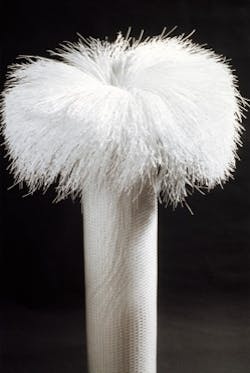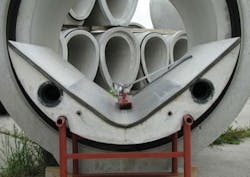Fort Lupton, Colorado, expanded capacity at its drinking water treatment plant. The project included adding a Clearlogx™ chemical feed control system from Siemens Water Technologies for DBP compliance. The project also replaced existing polypropylene membranes with PVdF membranes to gain additional membrane capacity. To reduce backwash wastes, the city also constructed a new flocculation/sedimentation facility followed by an Adsorption Clarifier® system to handle backwash wastes.
By Ian MacLeod and Russ Swerdfeger
Fort Lupton, CO, is a small city 30 miles northeast of Denver in an area that has suffered from drought for several years. Each year, watering restrictions are put in effect during the summer months.
In 1997, Fort Lupton began operation of a new nominally rated 5 mgd membrane filtration system. By 2008, due to irreversible fouling and other system inefficiencies, the throughput of the facility had been reduced to just over 3.5 mgd. Near that same point in time, the Colorado Department of Public Health and Environment notified the city of a Stage 1 Disinfection By-Products (DBP) violation. In response, the city piloted enhanced coagulation and granular activated carbon.
The pilot study revealed that enhanced coagulation was more cost-effective in this application. However, enhanced coagulation would have further reduced the plant’s capacity - to less than 3 mgd. Although the pilot proved its ability to meet DBP requirements, the contract city engineer, Clear Water Solutions (CWS), was concerned with the additional wastewater associated with enhanced coagulation and the need to acquire additional membranes to achieve the same plant capacity.
As an alternative, the city also investigated an inclined plate settler as pretreatment to the existing membrane system. The estimated cost of this alternative approached $5 million. In addition, all treatment components needed to fit into an existing building that had no capacity to expand. Having to comply with DBP regulations, adding additional membrane capacity and encumbering additional sewer infrastructure posed significant fiscal challenges to the city.
In response, Siemens Water Technologies worked with CWS to develop an innovative solution for the city. The first part consisted of adding the Clearlogx™ chemical feed control system for DBP compliance. The second part was replacing the existing polypropylene membranes with PVdF membranes to gain additional membrane capacity. The third aspect was related to addressing the city’s goal of reducing backwash wastes. This consisted of a new flocculation/sedimentation facility followed by an Adsorption Clarifier® system to handle backwash wastes. In early 2009, the city began installing the Clearlogx system and upgrading the membrane system. Installation of the backwash recovery system began in 2010 and was completed in early 2011.
Backwash Recovery
The membrane filters treat the incoming source water from Carter Lake. A backwash process periodically cleans the units, removing contaminates retained on the fibers’ surface. This backwash waste is equal to approximately 10% of the forward flow (3500 gpm incoming = 350 gpm of waste flow). The newly constructed backwash recovery process treats the membrane backwash waste stream and clarified water is returned to the head of the plant.
The waste stream from the new floc/sed basin and Adsorption Clarifier system is sent to the wastewater treatment plant (WWTP). Prior to the completion of this project, these flows represented approximately 10% of the total plant flow. Now, these wastes represent less than 2% of the plant flow, and the water is generally of better and more consistent quality than the water from Carter Lake.
The floc/sed process removes bulk backwash solids. As an added polishing step and to provide backup to the floc/sed process, the project included a high-rate Adsorption Clarifier system. The clarifier is ideal for light floc reduction, trapping solids inside the buoyant media similar to a filter bed. The buoyant media includes rolled and scarified beads to enhance floc capture and retention. Captured solids are periodically flushed from the clarifier media using raw water and air scouring. This eliminates the need for backwashing and wasting clarified water. The entire process is monitored and controlled by an integrated control system to ensure high-quality effluent is produced and operator attention is minimized. Finished water from the backwash waste recovery system is less than 2 NTU.
“The city had originally thought of installing a plate settler,” said Cort Nickel, P.E., principal at Clear Water Solutions in Windsor, Colo. “Although chemical feeds and waste streams are generally equal, the Adsorption Clarifier unit provides a much smaller footprint due to the loading rates achieved.”
The final project costs were less than half of the originally proposed budget, the filters have a higher yield than ever before, and the waste stream to the WWTP was reduced by almost an order of magnitude.
DBP Compliant
The combination of the Clearlogx system and the PVdF membrane upgrade brought Fort Lupton into Stages 1 and 2 DBP compliance. In addition to the treated water quality improvements, the Fort Lupton system upgrade increased the maximum peak day capacity from 3 to 5 mgd without expanding the membrane building. Additionally, with the implementation of the backwash recovery process, the plant now achieves an overall water recovery rate in excess of 98%. That marks an increased net water production of 8%.
Increased membrane flushing due to coagulant dosing required for TOC reduction would have required extensive sewer upgrades to handle the additional flow to the WWTP. By installing the backwash recovery process, the city saved in excess of $2 million in capital WWTF expenditures, decreased its source water usage by more than 8% (i.e. a net raw water gain of 8%), and lessened the load on the WWTP by mitigating waste generated.
(Clearlogx™ Chemical Feed System)
The Clearlogx automated chemical feed system enhances organic contaminant removal in water and wastewater, while simultaneously improving membrane and conventional filter performance.
Membrane treatment plants that require soluble organic removal employ a chemical coagulant to achieve this reduction via charge neutralization. These “charged” cationic particles attract to the anionic charged membrane material. By introducing a small dose of base solution (anions), the process can instantaneously alter this particle charge to emulate the membrane surface charge, thus eliminating “charge attraction.”
The Clearlogx system controls the addition of acid, coagulant, and chlorine dosing systems, and substantially reduces or eliminates chemical maintenance washes and CIPs. The technology decreases membrane fouling and reduces the formation of DBPs.
The technology is being integrated into Siemens’ Memcor® membrane systems, to support greater membrane performance for especially difficult-to-treat water sources.
WW
About the Authors : Ian MacLeod is the global conventional product manager for Siemens Industry’s Water Technologies Business Unit. He may be contacted at [email protected]. Russ Swerdfeger is a membranes product manager for Siemens. He may be contacted at [email protected].
More WaterWorld Current Issue Articles
More WaterWorld Archives Issue Articles






